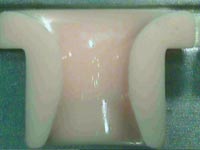

Why Diamond Lapping?
Air Wipes
Bow Guides
Eyelet Guides
Nozzle Guides
Pulleys
Ring Guides
Rods
Roller Guides
Snail Guides
Tube Guides
U- Guides
Welding Butts
Surface Finish
Glossary
Inquiry Forms
Materials
Site Map
How to Reduce Wear?
Wear, as defined by Noah Webster, is “impairment or loss due to friction” and "friction" is the rubbing of one object against another. So where there is rubbing, there is wear. Measures taken to counter the effects of friction include:
Elimination of rubbing
Introduction of lubricants
Reduction of surface roughness
Reducing Surface Roughness
Diamond Lapping reduces Surface Roughness by causing the molecular layers to shift their lattice position on the surface of the wire guide. In certain situations, this is the only approach----such as in the case of the common eyelet, where the guide directs the wire motion at a stationary position and the use of lubricants is impractical and rubbing could not be eliminated.
Below is a COSMOS Wire Guide Eyelet E 019 – 99 before and after diamond lapping, bisected for a unobstructed view of the interior:


Before After
As apparent from the photos, not only the entrance and exit of the eyelet have been processed but also the bore surface. In other words, the entire wire passage need to be thoroughly Diamond Lapped.
The Cost of Diamond Lapping has Come Down
The cost of Diamond Lapping, which inhibited its use in the past, has seen a reduction due to:
The reduced cost of the diamond grits in recent years
Advancements in Diamond Lapping technology
After a decade of advocating and promotion on our part and the ensuing appraisals won from shop floors worldwide, the wire manufacturing industry has fully accepted and entrusted the merits of the diamond polished wire guides. The continual advancements made in the diamond polishing process, in combination with more cost-effective, wear-resistant wire guides, will further accelerate the wire industry's contribution toward a greener planet.